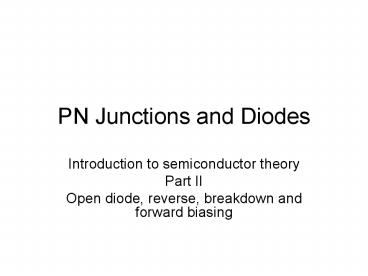PN Junctions and Diodes - PowerPoint PPT Presentation
1 / 37
Title:
PN Junctions and Diodes
Description:
Electric Field is created across Depletion region ... Electric field E is created. Field is not constant. E. Constant total charge on each side. ... – PowerPoint PPT presentation
Number of Views:95
Avg rating:3.0/5.0
Title: PN Junctions and Diodes
1
PN Junctions and Diodes
- Introduction to semiconductor theory
- Part II
- Open diode, reverse, breakdown and forward biasing
2
PN junction Concentrations
Anode
3
Minority and majority carriers concentrations
x
4
Its clear why we have diffusion currents, but
where are the drift currents coming from?...
5
How is the drift current IS created?
- Many holes that are diffused from the p-type
side into the n-type side recombine with
electrons. Likewise, for diffused electrons.
6
Depletion region is created
- The n side of the junction is full of ionized
donor atoms. The p side has many ionized acceptor
atoms. Depletion region has almost no free
carriers.
7
Electric Field is created across Depletion region
E
- The n side of the junction contains immobile
positively ionized donor atoms. The p side has
immobile negatively ionized acceptor atoms. - Electric field E is created. Field is not
constant.
8
Constant total charge on each side. Charges are
equal and opposite.
Field is created by integrating the charge over
x. Maximum field intensity is at x0.
Junction potential is obtained by integrating E
over x
9
Built-in Junction Potential
- Built-in junction potential
V0 depends both on the doping concentrations as
well as T. Typical value for V0 is 0.6 0.8 V
10
(No Transcript)
11
Depletion Region Widths on each side
- There is charge equality between both sides of
the depletion region
12
Depletion Region Width
Where es is the electrical permittivity of Si
11.7e0 1.0410-12 F/cm Concentrations are in
per cm3. Results unit is m. Typical width
are 0.1 1 µm.
13
Depletion Region example
- Let NA1017/cm3 and ND1016/cm3
- Let T300oK ? ni1.51010/cm3
- With these typical values, we obtain V0728mV.
- We then obtain Wdep0.32µm.
- Much of the depletion region will be on the n
side of the junction (10001 widths ratio)
14
Case 2 PN junction under reverse bias conditions
We shall analyze this case, assuming a forced
tiny reverse current
15
Actual circuit is driven by a reversely connected
battery
V must be smaller than the breakdown voltage
16
Observe electrons flowing in the external
circuit from the n type region to the p type
region
As electrons leave n region, holes leave p region
? Depletion region widens ? More charge
accumulates in depletion region
17
Observe electrons flowing in the external
circuit from the n type region to the p type
region
? Barrier voltage increases from V0 to V0VR,
where VR is the external reverse voltage ?
Diffusion current ID decreases, whereas drift
current IS remains unchanged IS-IDI
18
Depletion Region Width (VVR)
19
Depletion Region Capacitance
Grading coefficient m depends on the
concentration profile
20
Depletion Region Capacitance (Numerical Example)
For the typical values NA1017/cm3 and
ND1016/cm3 (T3000K), we obtain V00.728V ?
Cj00.32 fF/µm2 ? Cj0.41pF
21
What is IS?
- Whenever VR is connected, there is an initial
current that charges the depletion region
capacitor to qjqNqNDxNA - Steady state current is IS-IDIS as ID is very
small
22
Case 3 PN junction in the Breakdown Region
(VRltVZ)
- This time let us assume IgtIS
- As VR increases, depletion layers width
increases, and ID goes all the way to 0 - There is no steady state as IgtIS
- Barrier voltage increases.
23
Two Breakdown Mechanisms
- Zener Effect (VZlt5V)
- OR
- Avalanch Effect (VZgt7V)
24
Zener Effect
- As VR increases, the field E increases to a point
where it can break Si covalent bonds - ? Hole/electron pairs are created to supplement
the current in the reverse direction - ? Junction voltage stops increasing
25
Avalanch Effect
- As VR increases, speed of the minority carriers
increases to a point where by collision these
break Si covalent bonds - ? (as in the Zener effect)
- Breakdown, in any effect, is not destructive, as
long as the diodes power rating is not exceeded.
26
Case 4 PN junction in forward-bias conditions
- I carries electrons into the n-region and holes
into the p-region - HOW??
27
Forward biasing causes
- Depletion layer width decreases ? Barrier
voltage decreases ? More holes from p-region
cross over to the n-region (by diffusion), and
more electrons from n-region cross over to
p-region, by diffusion
28
Forward-biased junction currents
- The total diffusion current ID increases
- At steady state ID-ISI
29
V is the applied forward voltage. Pn(xn) result
above without proof
30
Minority carriers profile
- Another result (exponential profile)
- pn(x)pn,0 (pn(xn)-pn,0)exp-(x-xn)/LP
- LP is the diffusion length. It depends on the
steepness of the majority carriers profile
31
Diffusion Length
- pn(x)pn,0 (pn(xn)-pn,0)exp-(x-xn)/LP
- Typical value LP between 1 and 100 nm
- The smaller LP, the faster injected holes
recombine with majority electrons
32
Recombination Time Constant
- Let tP denote the average time for injected
minority holes recombination - Typical values for tP 1 to 104 ns
- Result LP(DP tP )1/2
33
Derivation of Diodes Steady State Holes Current
Formula
At steady state the current is constant
34
Diodes Steady State Electrons and Total Current
Formulas
Similar to holes current
Total diodes forward-bias current
35
Diodes Forward-Bias Total Current Formula
Replace pn,0 by ni2/ND and np,0 by ni2/NA
Where
36
Diodes Saturation Current IS
IS is directly proportional to the junction area A
IS strongly depends on the temperature due to the
ni2 coefficient
37
Numerical Example (Diode in Forward Bias)
- Let NA1017/cm3, ND1016/cm3, ni1.51010/cm3,
LP5µm, LN10µm, A2500 (µm)2, - DP (in n region) 10 cm2/Vs
- DN (in p region) 18 cm2/Vs
- Let I0.1mA
- Then IS210-15 A and V0.616 V































